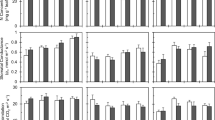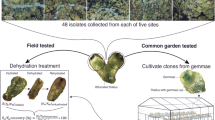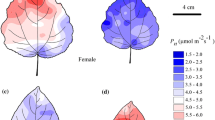Summary
Within the high arctic of Canada, Salix arctica, a dioecious, dwarf willow exhibits significant spatial segregation of the sexes. The overall sex ratio is female-biased and female plants are especially common in wet, higher nutrient, but lower soil temperature habitats. In contrast, male plants predominate in more xeric and lower nutrient habitats with higher soil temperatures that can be drought prone. Associated with the sex-specific habitat differences were differences in the seasonal and diurnal patterns of water use as measured by stomatal conductance to water vapor and the bulk tissue water relations of each gender. Within the wet habitats, female plants maintained higher rates of stomatal conductance (g) than males when soil and root temperatures were low (<4° C). In contrast, within the xeric habitats, male plants maintained higher g and had lower leaf water potentials Ψleaf at low soil water potentials and a high leaf-to-air vapor pressure gradient (Δw) when compared to females. Female plants had more positive carbon isotope ratios than males indicating a lower internal leaf carbon dioxide concentration and possibly higher water use efficiency relative to males. Tissue osmotic and elastic properties also differed between the sexes. Male plants demonstrated lower tissue osmotic potentials near full tissue hydration and at the turgor loss point and a lower bulk tissue elastic modulus (higher tissue elasticity) than female plants. Males also demonstrated a greater ability to osmotically adjust on a diurnal basis than females. These properties allowed male plants to maintain higher tissue turgor pressures at lower tissue water contents and Ψsoil over the course of the day. The sex-specific distributional and ecophysiological characteristics were also correlated with greater total plant growth and higher fecundity of females in wet habitats, and males in xeric habitats respectively. The intersexual differences in physiology persisted in all habitats. These results and those obtained from growth chamber studies suggest that sex-specific differences have an underlying genetic basis. From these data we conjecture that selection maintaining the intersexual differences may be related to different costs associated with reproduction that can be most easily met through physiological specialization and spatial segregation of the sexes among habitats of differing conditions.
Similar content being viewed by others
References
Acevedo E, Fereres E, Hsiao TC, Henderson DC (1979) Diurnal growth trends, water potential, and osmotic adjustment of maize and sorghum leaves in the field. Plant Physiol 64:476–480
Babb TA, Whitfield DWA (1977) Mineral nutrient cycling and limitation of plant growth in the Truelove Lowland ecosystem. In: Bliss LC (ed) Truelove Lowland, Devon Island, Canada: A High Arctic Ecosystem, University of Alberta Press, Edmonton. pp 587–620
Baker HG (1959) Reproductive methods as factors in specialization in flowering plants. Cold Spring Harbor Symp Quant Biol 24:177–191
Bateman AJ (1948) Intra-sexual selection in Drosophila. Heredity 2:349–368
Bawa KS (1980) Evolution of dioecy in flowering plants. Ann Rev Ecol Syst 11:15–39
Bierzychudek P, Eckhart V (1988) Spatial segregation of the sexes of dioecious plants. Am Nat 132:34–43
Bowman WD (1988) Ionic and water relations responses of two populations of a non-halophyte to salinity. J Exp Bot 39:97–105
Bullock S, Bawa KS (1981) Sexual dimorphism and annual flowering pattern in Jacaratia dolichaula (D. Smith) Woodson (Caricaceae) in a Costa Rican rainforest. Ecology 64:851–861
Bunce JA (1977) Leaf elongation in relation to leaf water potential in soybean. J Exp Bot 28:156–161
Calkin HW, Pearcy RW (1984) Seasonal progressions of tissue and cell water relations parameters in evergreen and deciduous perennials. Plant, Cell Environ 7:347–352
Chapin DM, Bliss LC (1988) Soil-plant water relations of two subalpine herbs from Mount St. Helens. Can J Bot 66:809–818
Charnov EL (1982) The Theory of Sex Allocation. Monogr in Pop Biol, Princeton University Press, Princeton
Charnov EL, Dawson TE (1989) Environmental sex determination with overlapping generations. Am Nat 134 (in press)
Cox PA (1981) Niche partitioning between the sexes of dioecious plants. Am Nat 117:295–307
Cox PA (1982) Vertebrate pollination and the maintenance of dioecism in Freycinetia. Am Nat 120:62–80
Crawford RMM, Balfour J (1983) Female predominant sex ratios and physiological differentiation in arctic willows. J Ecol 71:149–160
Danell K, Elmqvist T, Ericson E, Salomonson A (1985) Sexuality in willows and preferences by bark-eating voles: defence or not? Oikos 44:82–90
Darwin C (1877) The Different Forms of Flowers on Plants of the Same Species. John Murray, London
Dawson TE (1987) Comparative ecophysiological adaptations in arctic and alpine populations of a dioecious shrub, Salix arctica. Dissertation, University of Washington, Seattle
Dawson TE, Bliss LC (1989) Intraspecific variation in the water relations of Salix arctica, an arctic-alpine dwarf willow. Oecologia 79:322–331
Dzhaparidze LI (1969) Sex in Plants. Akademiya Nauk Gruzinskoi SSR. Institut Botaniki. Translated from Russian for the NSF
Ehleringer JR (1983) Ecophysiology of Amaranthus palmeri, a Sonoran Desert summer annual. Oecologia 57:107–112
Ehleringer JR, Osmond CB (1989) Stable Isotopes. In: Pearcy, RW, Ehleringer JR, Mooney HA, Rundel PW (eds) Methods in Plant Physiological Ecology. Chapman and Hall Ltd., London
Ehleringer JR, Rundel PW, Nagy KA (1986) Stable isopotes in physiological ecology and food web research. Trends Ecol Syst 1:42–45
Elmqvist T, Ericson L, Danell K, Salomonson A (1988) Latitudinal sex ratio variation in willows, Salix spp., and gradients in vole herbivory. Oikos 51:259–266
Farquhar GD, Richards RA (1984) Isotopic composition of plant carbon correlates with water-use efficiency of wheat genotypes. Aust J Plant Physiol 11:539–552
Farquhar GD, O'Leary MH, Berry JA (1982) On the relationship between carbon isotope discrimination and the intercellular carbon dioxide concentration in leaves. Aust J Plant Physiol 9:121–137
Feduccia A, Slaughter BH (1974) Sexual dimorphism in skates (Rajidae) and its possible role in differential niche utilization. Evolution 28:164–168
Freeman DC, McArthur ED (1982) A comparison of twig water stress between males and females of six species of desert shrubs. For Sci 28:304–308
Freeman DC, Vitale JJ (1985) The influence of environment on the sex ratio and fitness of spinach. Bot Gaz 146:137–142
Freeman DC, Klikoff LG, Harper KT (1976) Differential resource utilization by sexes of dioecious plants. Science 193:597–599
Fox JF, Harrison AT (1981) Habitat assortment of the sexes and water balance in a dioecious grass. Oecologia 49:233–235
Givnish TJ (1982) Outcrossing versus ecological constraints in the evolution of dioecy. Am Nat 119:849–865
Gould SJ, Vrba E (1982) Exaptations — a missing term in the science of form. Paleobiology 8:4–15
Gross KL, Soule JD (1981) Differences in biomass allocation to reproductive and vegetative structures of male and female plants of a dioecious, perennial herb, Silene alba (Miller) Krause. Am J Bot 68:801–807
Hamilton WD (1967) Extraordinary sex ratios. Science 156:477–488
Havranek WM (1970) Über die Bedeutung der Bodentemperatur für die Photosynthese und Transpiration junger Forstpflanzen und für die Stoffproduktion an der Waldgrenze. Angew Bot 46:101–116
Hinckley TM, Ritchie GA (1972) Reaction of mature Abies seedlings to environmental stresses. Trans Mo Acad Sci 6:24–37
Hinckley TM, Duhme F, Hinckley AR, Richter H (1980) Water relations of drought hardy shrubs: osmotic potential and stomatal reactivity. Plant, Cell Environ 3:131–140
Hsiao TC, Acevedo E, Ferreres E, Henderson DW (1976) Water stress, growth, and osmotic adjustment. Phil Trans Royal Soc London B 273:479–500
Jones MM, Rawson HM (1979) Influence of rate of development of leaf water deficits upon photosynthesis, leaf conductance, water use efficiency, and osmotic potential in Sorghum. Physiol Plant 45:103–111
Kaufmann MR (1975) Leaf water stress in Engelmann spruce. Influence of root and shoot environments. Plant Physiol 56:841–844
Knipling ED (1967) Effects of leaf aging on water deficit-water potential relationships of dogwood leaves growing in two environments. Physiol Plant 20:65–72
Ladiges PY (1975) Some aspects of tissue water relations in three populations of Eucalyptus vininalis Labill. New Phytol 75:53–62
Lloyd DG, Bawa KS (1984) Modification of the gender of seed plants in varying conditions. In: Hecht MK, Wallace B, Prance GT (eds) Evolutionary Biology vol 17, Plenum Press, New York. pp 255–335
Lloyd DG, Webb CJ (1977) Secondary sex characteristics in seed plants. Bot Rev 43:177–216
Lovett Doust J, O'Brien G, Lovett Doust L (1987) Effects of density on the secondary sex characteristics and sex ratio in Silene alba (Caryophyllaceae). Am J Bot 74:40–46
MacKay DB (1972) The measurement of viability. In: Roberts EH (ed) Viability of Seeds. Chapman and Hall Ltd, London. pp 172–208
Maynard Smith J (1978) Optimization theory in evolution. Ann Rev Ecol Syst 9:31–56
Meagher TR (1980) The population biology of Chamaelirium luteum, a dioecious lity. I. Spatial distribution of males and females. Evolution 34:1127–1137
Meagher TR (1984) Sexual dimorphism and ecological differentiation of male and female plants. Ann Misso Bot Gard 71:254–264
Meagher TR, Antonovics J (1982a) Life history variation in dioecious plant populations: a case study of Chamaelirium luteum. In: Dingle H, Hegmann JP (eds) Evolution and Genetics of Life Histories. Springer-Verlag, New York. pp 139–154
Meagher TR, Antonovics J (1982b) The population biology of Chamaelirium luteum, a dioecious member of the lity family. III. Life history studies. Ecology 63:1690–1700
Meinzer FC, Rundel PW, Sharifi MR, Nilsen ET (1986) Turgor and osmotic relations of the desert shrub Larrea tridentata. Plant, Cell Environ 9:467–475
Morgan JM (1984) Osmoregulation and water stress in higher plants. Ann Rev Plant Physiol 35:299–319
Nunney L (1985) Female biased sex ratios: individual or group selection? Evolution 39:349–361
O'Donald P (1980) Genetic Models of Sexual Selection. Cambridge University Press, Cambridge
Onyekwelu SS, Harper JL (1979) Sex ratio and niche differentiation in spinach (Spinacia oleracea L.). Nature 282:609–611
Parker WC, Pallardy SG (1987) The influence of resaturation method and tissue type on pressure-volume analysis of Quercus alba L. seedlings. J Exp Bot 38:535–549
Pavlick BM (1984) Seasonal changes in osmotic pressure, symplastic water content, and tissue elasticity in the blades of dume grasses growing in situ along the coast of Oregon. Plant, Cell Environ 7:531–539
Roberts SW, Strain BR, Knoerr KR (1980) Seasonal patterns of leaf water relations in four co-occuring forest tree species: parameters from pressure-volume curves. Oecologia 46:330–337
Robichaux RH (1984) Variation in the tissue water relations of two sympatric Hawaiian Dubautia species and their natural hybrid. Oecologia 65:75–81
Robichaux RH, Holsinger KE, Morse SR (1986) Turgor maintenance in Hawaiian Dubautia species: the role of variation in tissue osmotic and elastic properties. In: Givnish TJ (ed) On the Economy of Plant Form and Function, Cambridge University Press, Cambridge, pp 353–380
Samson DA, Werk KS (1986) Size-dependent effects in the analysis of reproductive effort in plants. Am Nat 127:667–680
Selander R (1972) Sexual selection and dimorphism in birds. In: Campbell B (ed) Sexual Selection and the Descent of Man, 1871–1971, Aldine, Chicago. pp 180–230
Takami S, Turner NC, Rawson HM (1981) Leaf expansion of four sunflower (Helianthus annuus L.) cultivars in relation to water deficits. I. Patterns during development. Plant, Cell Environ 4:399–407
Takami S, Turner NC, Rawson HM (1982) Leaf expansion of four sunflower (Helianthus annuus L.) cultivars in relation to water deficits. II. Diurnal patterns during stress and recovery. Plant, Cell Environ 5:279–286
Teskey RO, Hinckley TM, Grier CC (1984) Temperature-induced changes in the water relations of Abies amabilis (Dougl.) Forbes. Plant Physiol 74:77–80
Thompson JD, Barrett SCH (1981) Selection for outerossing, sexual selection and the evolution of dioecy in plants. Am Nat 118:443–449
Turner NC, Jones MM (1980) Turgor maintenance by osmotic adjustment: a review and evaluation. In: Turner NC, Kramer PJ (eds) Adaptation of Plants to Water and High Temperature Stress, John Wiley and Sons, New York. pp 87–103
Tyree MT, Jarvis P (1982) Water in tissues and cells. In: Lange OL, Nobel PS, Osmond CB, Ziegler H (eds) Encyclopedia of Plant Physiology, new series, vol 12B, Springer, Berlin Heidelberg New York, pp 35–77
Tyree MT, Cheung YNS, McGregor ME, Talbot AJB (1978) The characteristics of seasonal and ontogenetic changes in tissuewater relations of Acer, Populus, Tsuga and Picea. Can J Bot 56:635–647
Van Volkenburgh E, Cleland RE (1985) Wall yield threshold and effective turgor in growing bean leaves. Planta 167:37–43
Walker BD, Peters TW (1977) Solis of Truelove Lowland and planteau. In: Bliss LC (ed) Truelove Lowland, Devon Island, Canada: A High Arctic Ecosystem, University of Alberta Press, Edmonton, pp 31–62
Wallace CS, Rundel PW (1979) Sexual dimorphism and resource allocation in male and female shrubs of Simmondsia chinensis. Oecologia 44:34–39
Waser NW (1984) Sex ratio variation in populations of a dioecious desert perennial, Simmondsia chinensis. Oikos 42:343–348
Willson MF (1983) Plant Reproductive Ecology. Wiley-Interscience, New York
Wilson JR, Fisher MJ, Schulze E-D, Dolby GR, Ludlow MM (1979) Comparison between pressure-volume and dewpoint-hygrometry techniques of determining the water relations characteristics of grass and legume leaves. Oecologia 41:77–88
Zimmerman JK, Lechowicz MJ (1982) Responses to moisture stress in male and female plants of Rumex acetosella L. (Polygonaceae). Oecologia 53:305–309
Author information
Authors and Affiliations
Rights and permissions
About this article
Cite this article
Dawson, T.E., Bliss, L.C. Patterns of water use and the tissue water relations in the dioecious shrub, Salix arctica: the physiological basis for habitat partitioning between the sexes. Oecologia 79, 332–343 (1989). https://doi.org/10.1007/BF00384312
Received:
Published:
Issue Date:
DOI: https://doi.org/10.1007/BF00384312




